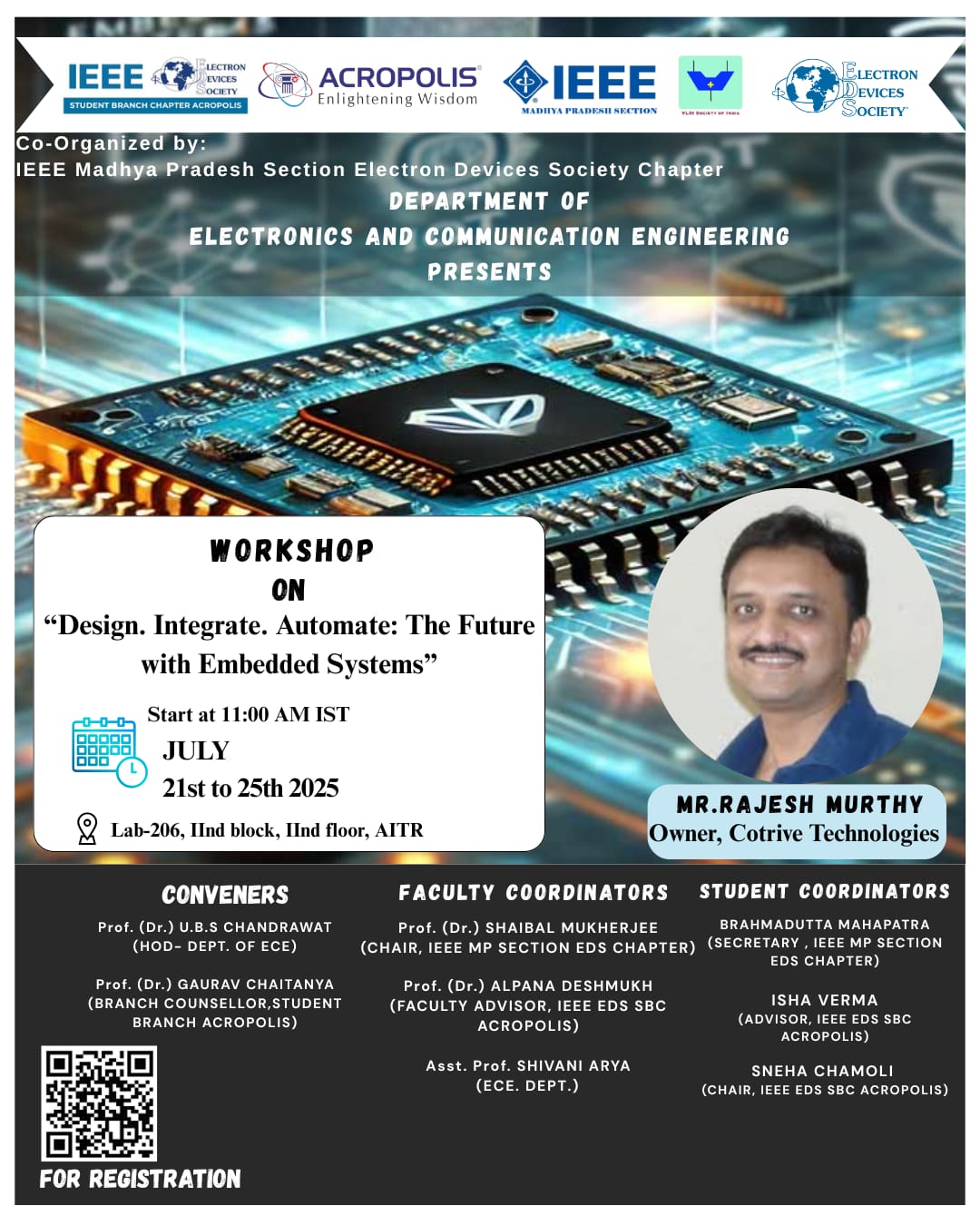Design Integrate Automate: The future with Embedded System
AITR Indore
Design : At the heart of every embedded system lies intelligent design — the process of crafting efficient, reliable, and application-specific hardware-software solutions. Whether it's a microcontroller-based IoT device or a real-time automotive control system, the design phase ensures:
-
Optimal resource utilization
-
Power efficiency
-
Performance tuning
-
Integration with sensors, actuators, and networks
Modern embedded design leverages tools like HDL (for hardware), RTOS (for scheduling), and embedded C/C++ (for firmware), pushing innovation in fields like robotics, healthcare, smart wearables, and automation.
Integrate
Integration is where embedded systems truly shine. As systems grow smarter and more interconnected, the challenge becomes seamless integration of hardware, software, communication protocols, and cloud services. This phase involves:
-
Merging embedded modules into larger systems (e.g., drones, autonomous cars)
-
Ensuring interoperability via protocols like SPI, I2C, UART, CAN, and MQTT
-
Combining AI, machine learning, and edge computing capabilities
-
Facilitating real-time decision making across systems
Integration is the key enabler of smart ecosystems — from smart homes to Industry 4.0.
Automate
Embedded systems are the engine of automation. Once designed and integrated, they enable machines to perform tasks without human intervention — accurately, efficiently, and consistently. This automation includes:
-
Intelligent process control in manufacturing
-
Real-time diagnostics in medical devices
-
Precision agriculture using drones and sensors
-
Autonomous navigation in vehicles and robots
As AI and IoT merge with embedded systems, automation becomes more adaptive, predictive, and autonomous.
🌐 The Future with Embedded Systems
The future promises ubiquitous intelligence, where every device — no matter how small — becomes smart, connected, and capable of autonomous decision-making. Embedded systems are the backbone of:
-
Smart cities
-
Autonomous transport
-
Personalized healthcare
-
Sustainable energy systems
-
Consumer electronics evolution
With rapid advancements in SoC (System on Chip), low-power design, and AI-at-the-edge, embedded systems are driving a new digital era where Design, Integrate, Automate is not just a process — it's a paradigm.
Date and Time
Location
Hosts
Registration
-
 Add Event to Calendar
Add Event to Calendar
- Acropolis Institue of Technology and Rearch Indore
- MAGALIA
- INDORE, Madhya Pradesh
- India 452016
- Building: BLOCK 2
- Room Number: 206
- Contact Event Hosts
- Co-sponsored by IEEE EDS MP Section and Acrpolis Institute of Technology and Research Indore
Speakers
Mr. Rajesh Murthy of Contrive Technology Indore
Design Integrate Automate: The future with Embedded System
Design : At the heart of every embedded system lies intelligent design — the process of crafting efficient, reliable, and application-specific hardware-software solutions. Whether it's a microcontroller-based IoT device or a real-time automotive control system, the design phase ensures:
-
Optimal resource utilization
-
Power efficiency
-
Performance tuning
-
Integration with sensors, actuators, and networks
Modern embedded design leverages tools like HDL (for hardware), RTOS (for scheduling), and embedded C/C++ (for firmware), pushing innovation in fields like robotics, healthcare, smart wearables, and automation.
Integrate
Integration is where embedded systems truly shine. As systems grow smarter and more interconnected, the challenge becomes seamless integration of hardware, software, communication protocols, and cloud services. This phase involves:
-
Merging embedded modules into larger systems (e.g., drones, autonomous cars)
-
Ensuring interoperability via protocols like SPI, I2C, UART, CAN, and MQTT
-
Combining AI, machine learning, and edge computing capabilities
-
Facilitating real-time decision making across systems
Integration is the key enabler of smart ecosystems — from smart homes to Industry 4.0.
Automate
Embedded systems are the engine of automation. Once designed and integrated, they enable machines to perform tasks without human intervention — accurately, efficiently, and consistently. This automation includes:
-
Intelligent process control in manufacturing
-
Real-time diagnostics in medical devices
-
Precision agriculture using drones and sensors
-
Autonomous navigation in vehicles and robots
As AI and IoT merge with embedded systems, automation becomes more adaptive, predictive, and autonomous.
🌐 The Future with Embedded Systems
The future promises ubiquitous intelligence, where every device — no matter how small — becomes smart, connected, and capable of autonomous decision-making. Embedded systems are the backbone of:
-
Smart cities
-
Autonomous transport
-
Personalized healthcare
-
Sustainable energy systems
-
Consumer electronics evolution
With rapid advancements in SoC (System on Chip), low-power design, and AI-at-the-edge, embedded systems are driving a new digital era where Design, Integrate, Automate is not just a process — it's a paradigm.
Email:
Address:Owner Contrive Technology, , Indore
Agenda
(IEEE EDS SB Chapter) and (IEEE MP SECTION EDS CHAPTER)

